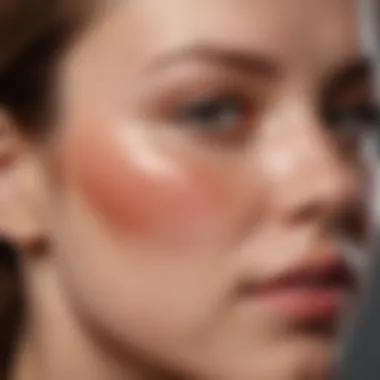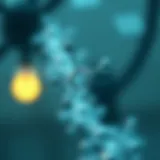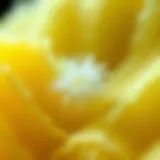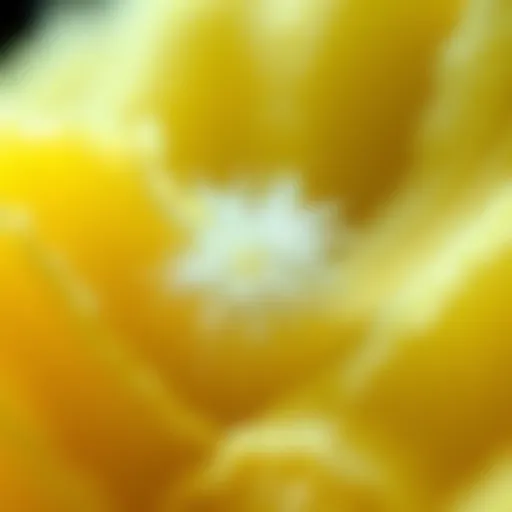Understanding Polycystic Acne: Causes and Treatments


Research Context
Background Information
Polycystic acne is a type of acne, but it is distinguished from other forms due to its specific characteristics. Typically, it involves large, painful cysts underneath the skin, often affecting areas like the face, back, and shoulders. The condition is often a manifestation of underlying hormonal disparities, most notably involving androgens, which can provoke excess oil production and inflammation in hair follicles. This interplay of hormones and skin functions creates a perplexing condition that goes beyond typical acne.
This dermatological issue can arise in conjunction with other symptoms related to hormonal dysregulation. Patients may also experience menstrual irregularities or other metabolic disturbances, such as insulin resistance. Understanding these interrelated factors is crucial for both diagnostics and treatment.
Importance of the Study
The relevance of studying polycystic acne cannot be overstated. It affects a significant population, impacting not only physical health but also psychological well-being and quality of life. Many individuals with this condition may face stigma or emotional distress due to visible skin lesions and potential scarring.
Furthermore, awareness around the topic remains limited, which often leads to misdiagnosis and inadequate treatment options. This article aims to provide clarity by synthesizing existing research and exploring the myriad aspects of the condition, including its causes, available treatment modalities, and effective management strategies.
Discussion
Interpretation of Results
Current research highlights the multi-faceted nature of polycystic acne. Studies indicate that hormonal testing, especially to check for elevated androgen levels, can provide insights into the underlying causes. Additionally, genetic predisposition is showing increasing significance as a contributing factor. Determining whether the acne is indeed related to polycystic ovaries or another hormonal imbalance can inform treatment plans, which vary widely but may involve lifestyle changes, medications, or other interventions.
Comparison with Previous Research
In contrast to older studies which largely focused on external treatments, recent findings advocate for a more integrated approach that includes lifestyle modifications in conjunction with pharmacologic treatments. For instance, incorporating a low-glycemic diet has emerged as a potential adjunct to medical therapy, showing promise in reducing symptoms and improving overall skin health.
Healthcare professionals are beginning to recognize that a holistic perspective is necessary to address both the physical and emotional components of this condition effectively.
"Polycystic acne may indicate deeper hormonal imbalances that require a comprehensive management strategy rather than isolated treatments."
Prolusion to Polycystic Acne
Understanding polycystic acne requires a framework of its complexities. It is more than just occasional breakouts. Polycystic acne is a chronic skin condition that presents a unique set of challenges for those affected. Hormonal imbalances often trigger this condition, leading to the formation of cystic lesions and other skin issues. Recognizing what makes polycystic acne distinct helps in effective management and treatment strategies.
Individuals suffering from this condition should be informed about the underlying causes and the various treatment options available. This foundational knowledge empowers patients to seek targeted therapies that match their specific scenarios.
Consumer awareness around polycystic acne is increasingly essential given its prevalence and impact on quality of life. Exploring this condition promotes informed decision-making and enhances management strategies. It also leads to a greater understanding of how lifestyle choices can influence skin health.
Defining Polycystic Acne
Polycystic acne is characterized by multiple cystic lesions and often occurs in association with other conditions, such as polycystic ovary syndrome (PCOS). It involves the overproduction of oils in the skin and often results in larger, inflamed cysts compared to typical acne. The skin will often display both inflammatory and non-inflammatory lesions, leading to significant discomfort and emotional distress for those affected.
Understanding polycystic acne is essential as it requires a different approach than regular acne. The treatment strategy should be tailored to address hormonal factors, making timely diagnosis critical.
Prevalence and Demographics
Polycystic acne appears to be increasingly prevalent across various demographics. Studies indicate that it predominantly affects women, especially those of reproductive age. Surprising percentages of young adults report problematic symptoms related to this acne type. Factors that contribute to these high rates include:
- Hormonal fluctuations: These are common during puberty, menstruation, and pregnancy, making women more susceptible.
- Genetic predisposition: Family history may also amplify the risk for many individuals.
- Lifestyle factors: Stress and diet can exacerbate symptoms, further complicating the demographic landscape.
Understanding these elements helps in framing prevention and intervention strategies. Recognizing the groups most affected allows for targeted educational initiatives and tailored support resources.
"Acknowledging the complexities of polycystic acne is the first step toward effective management. By understanding its unique nature, individuals can combat its impact more effectively."
Being informed about prevalence and demographics can lead to better resource allocation and support for those facing this challenging condition.
Pathophysiology of Polycystic Acne
Understanding the pathophysiology of polycystic acne is essential for a thorough comprehension of the condition. This knowledge can guide treatment options and management strategies effectively. The interplay between hormones and sebaceous gland activity plays a pivotal role in the acne's development, making it crucial to explore these aspects in depth. Here, we will examine hormonal influences, with a focus on androgens and insulin resistance, as well as the activity of sebaceous glands.
Hormonal Influences
Hormones significantly impact the skin, particularly in the context of acne. They can drive the development of cystic lesions and increase oil production. Two primary hormonal influences are androgens and insulin resistance.
Role of Androgens
Androgens are male hormones present in both men and women, though in varying levels. They contribute to the development of polycystic acne by stimulating oil production in the sebaceous glands. Elevated androgen levels can lead to enlarged sebaceous glands, resulting in increased sebum production. This overproduction is a key characteristic of polycystic acne.
The significance of androgens in this article lies in their role as a primary trigger for acne mechanisms. Since many acne treatments target androgen levels, understanding this hormone’s influence is beneficial for developing effective management approaches. However, it is worth noting that managing androgens can be a double-edged sword due to potential side effects.
Insulin Resistance
Insulin resistance describes a condition where cells do not respond properly to insulin, leading to elevated insulin levels in the bloodstream. This condition can stimulate the ovaries to produce more androgens, further exacerbating acne symptoms. The link between insulin resistance and hormone production highlights a major underlying mechanism in polycystic acne.
The key characteristic of insulin resistance makes it a popular focus in discussions about treatment strategies. Improving insulin sensitivity can help regulate hormonal levels, thereby reducing acne severity. However, addressing insulin resistance often requires comprehensive lifestyle changes, which may not be easy for everyone.


Sebaceous Gland Activity
Sebaceous glands are responsible for producing sebum, an oily substance that helps keep the skin hydrated. In polycystic acne, these glands often become overactive due to the hormonal influences discussed earlier. This heightened activity leads to the clogging of skin pores, resulting in cyst formation and inflammatory responses.
Understanding sebaceous gland activity is vital because it serves as a key factor in acne pathophysiology. Treatments often aim to manage the output of these glands to achieve clearer skin. However, excessively reducing sebum can lead to dryness and irritation, which may counteract the goal of maintaining healthy skin.
The pathophysiology of polycystic acne intertwines various physiological factors, making it imperative for an effective treatment and management plan.
Examining these elements provides a clearer picture of how to approach polycystic acne effectively. It emphasizes the necessity for a nuanced understanding that goes beyond superficial treatments. By exploring hormonal influences and sebaceous gland activity, this article lays the groundwork for discussing causes, symptoms, and appropriate treatments in subsequent sections.
Identifying Causes
Understanding the causes of polycystic acne is essential for effective treatment and management. Identifying these factors can help tailor interventions and improve overall outcomes. It can also provide insight into the complexity of this condition, emphasizing the interplay of various influences, including genetic, environmental, and lifestyle factors. Moreover, understanding the causes can enhance patient education and foster a proactive approach to managing polycystic acne.
Genetic Factors
Genetic factors play a critical role in the development of polycystic acne. A family history of similar skin issues may indicate a hereditary component. Specific genes associated with hormonal regulation may predispose individuals to imbalances that lead to acne. Research indicates that a genetic predisposition can heighten the risk of developing this condition, particularly among certain ethnic groups.
Environmental Triggers
Pollution
Pollution is a significant environmental trigger for polycystic acne. The pollutants in the air can irritate the skin, leading to inflammation and exacerbation of acne symptoms. The exposure to airborne toxins can increase oxidative stress on the skin, resulting in a breakdown of its natural barrier.
The key characteristic of pollution relating to polycystic acne is its ability to disrupt skin homeostasis. This topic is relevant because urban environments, where pollution levels are often higher, may see a greater incidence of acne among residents.
The unique feature of pollution is its ubiquitous nature, impacting almost everyone living in densely populated areas. The disadvantages include the difficulty in controlling exposure, making it a challenging factor to manage in acne treatment.
Dietary Influences
Dietary influences also contribute to the development of polycystic acne. Nutrient intake can affect hormonal balance, particularly with foods high in refined sugars and dairy. Such dietary choices can lead to increased insulin levels, which may trigger sebum production and worsen acne conditions.
The key characteristic of dietary influences is their direct relationship with hormonal activity. This connection makes it a valuable topic for this article as dietary modification can serve as a preventative strategy.
A unique feature of dietary influences includes the potential for individual variability—what may trigger acne in one person might not affect another the same way. This variability presents both advantages and disadvantages, particularly concerning personalization of dietary plans for acne management.
Lifestyle Factors
Stress
Stress is another lifestyle factor that significantly impacts polycystic acne. When under stress, the body produces more cortisol, a hormone that can stimulate sebaceous gland activity, leading to increased acne formation. Recognizing stress as a contributor highlights the psychosomatic aspects of this condition.
The key characteristic of stress is its dual role; it may not only contribute to acne but also result from the psychological burden of having skin issues. This understanding is beneficial for individuals seeking comprehensive management approaches that address underlying emotional health along with physical symptoms.
Sleep Patterns
Sleep patterns affect skin health and can influence the severity of polycystic acne. Lack of sufficient sleep can disrupt hormonal balance and promote inflammation. Quality sleep is essential for recovery and maintaining healthy skin.
The key characteristic of sleep patterns is the biological necessity of restorative rest for overall wellbeing. This topic is beneficial as it connects lifestyle habits with skin health.
A unique feature of sleep patterns is their holistic nature; improving sleep can enhance overall health beyond skin conditions. However, addressing sleep irregularities can be challenging depending on individual circumstances and lifestyle commitments.
Symptoms and Diagnosis
Understanding the symptoms and diagnosis of polycystic acne is crucial in the journey toward effective management and treatment. Recognizing the distinctive signs of this condition allows individuals to seek appropriate help and possibly prevent further complications. Accurate diagnosis also helps differentiate polycystic acne from other skin disorders, ensuring that the correct treatment is administered.
Common Symptoms
Cyst Formation
Cyst formation is a primary symptom of polycystic acne. These cysts, which are fluid-filled sacs, can vary in size and often appear deep beneath the skin. They contribute significantly to the condition as they are a direct result of clogged pores and excessive oil production. A key characteristic of cysts is their potential to cause scarring, which can lead to long-lasting skin issues.
Cyst formation is important to recognize because it marks the difference between standard acne and polycystic acne. This distinction informs treatment choices. While some may treat regular acne with over-the-counter solutions, polycystic acne often requires a multifaceted approach.
One unique feature of cyst formation is its association with hormonal imbalances, most notably involving androgens. This link emphasizes the importance of addressing underlying hormonal issues in treatment plans. Although cysts can be painful and distressing, appropriate medical intervention can often reduce their incidence and impact.
Inflammatory Responses
Inflammatory responses are another common symptom associated with polycystic acne. The skin may appear red, swollen, and sensitive, indicating a reaction to the cysts and clogged pores. This response can compound the emotional distress experienced by individuals with this condition. The key characteristic of inflammatory responses is the body's natural defense mechanism reacting to perceived threats, which in this case are the cysts.
The significance of recognizing these responses lies in their role during diagnosis and treatment. A pronounced inflammatory response often indicates the severity of the condition, guiding healthcare professionals in selecting the appropriate management strategies.
One unique feature of inflammatory responses is their variability among individuals. Some experience mild symptoms, while others endure intense redness and irritation. This discrepancy can make diagnosis and treatment more complex, highlighting the need for personalized approaches.
Diagnostic Criteria


Diagnostic criteria for polycystic acne include clinical assessment, patient history, and sometimes laboratory tests. Practitioners look for the presence of cystic lesions and inflammatory spots on the face, back, and other areas. Frequently, a dermatological evaluation is essential. Certain criteria, such as the Rotterdam criteria, may guide practitioners in diagnosing polycystic ovarian syndrome, which is often related to acne manifestations. A thorough understanding of these criteria can enhance diagnostic accuracy and treatment effectiveness.
Proper diagnosis is paramount in tailoring appropriate treatment strategies and improving quality of life for those affected.
Treatment Options
Treatment options for polycystic acne are crucial as they provide various methods to address this complex skin condition. Effective treatments can help mitigate symptoms and improve the quality of life for those affected. Understanding the range of available options contributes to informed decision-making for individuals seeking relief from the challenges posed by polycystic acne. The focus is on tailoring treatment to each person's specific needs, as this condition can vary significantly in its expression.
Topical Treatments
Topical treatments are often the first line of defense in managing polycystic acne. These treatments are applied directly to the skin, allowing for targeted action. They can play an essential role in reducing inflammation, preventing new lesions, and managing existing acne.
Retinoids
Retinoids are a class of vitamin A derivatives commonly used in the treatment of acne. They regulate skin cell turnover, which helps to prevent clogged pores. Understanding retinoids' significant aspect is their effectiveness in promoting the shedding of dead skin cells, which can contribute to acne formation. Retinoids are a popular choice due to their dual action: they clear existing acne while preventing future breakouts. However, they can cause irritation, especially at the beginning of treatment. Users may experience dryness and peeling, making it important to introduce them gradually.
Antibiotics
Antibiotics can also be a key element in treating polycystic acne, especially when there is an inflammatory component. They work by reducing bacterial growth on the skin and decreasing inflammation. Antibiotics are valuable for those who have significant redness and swelling associated with their acne. A unique feature of antibiotics is their ability to promote healing in inflamed lesions, which can lead to a quicker resolution of acne symptoms. However, prolonged use may lead to antibiotic resistance, which is a serious consideration. It is essential to balance effectiveness with the risk of resistance when choosing antibiotics as a treatment option.
Oral Medications
Oral medications are often necessary for more severe cases of polycystic acne. They offer systemic treatment that can directly address hormonal influences implicated in this condition. The decision to use oral medications should involve careful evaluation of the individual's specific situation and consideration of potential side effects.
Hormonal Therapies
Hormonal therapies are particularly beneficial for women experiencing acne linked to hormonal fluctuations. These treatments can help balance hormones and reduce sebum production. A key characteristic of hormonal therapies is their ability to target the root cause of the acne. Birth control pills, for instance, can regulate menstrual cycles and decrease androgen levels, leading to improved skin condition. The advantages include a significant reduction in acne lesions; however, potential disadvantages such as side effects need to be discussed with a healthcare provider.
Isotretinoin
Isotretinoin is a powerful oral medication used for severe acne that has not responded to other treatments. It works by reducing the size of sebaceous glands and lowering sebum production. The unique feature of isotretinoin is its ability to provide a long-term solution for acne, with many patients experiencing prolonged remission after treatment. However, it is associated with serious side effects, including potential liver damage and teratogenic effects, leading to rigorous monitoring and use of contraceptives during treatment. This underscores the importance of careful patient education and follow-up.
Alternative Therapies
Alternative therapies can complement traditional treatment strategies for polycystic acne. While not universally accepted in all medical circles, these approaches can provide additional options for individuals seeking relief from their symptoms.
Herbal Remedies
Herbal remedies have gained popularity for their perceived natural approach to treating acne. Common options include tea tree oil and green tea extracts, known for their antibacterial and anti-inflammatory properties. The key characteristic of herbal remedies lies in their appeal to those preferring non-pharmaceutical solutions. One of the advantages is the lower likelihood of side effects compared to conventional medications. However, their effectiveness can be variable, and rigorous scientific evidence on their efficacy is often lacking. Thus, individuals should approach herbal treatments cautiously, ideally in conjunction with medical advice.
Acupuncture
Acupuncture is another alternative therapy that some individuals find beneficial for polycystic acne. This technique involves inserting thin needles into specific points on the body to stimulate healing and balance energy. The key characteristic of acupuncture lies in its holistic framework, addressing not just the skin but the overall well-being of the patient. Some studies suggest that acupuncture may reduce inflammation and stress levels, which are both important factors in managing acne. However, more rigorous studies are needed to establish its effectiveness and understand its role in acne treatment comprehensively.
In summary, treatment options for polycystic acne require careful selection based on individual needs, preferences, and potential side effects. Understanding the various approaches allows individuals to make informed decisions regarding their skin health.
Lifestyle Modifications
Lifestyle modifications play a crucial role in managing polycystic acne. They do not only focus on the clinical aspects but also help create a holistic approach to the condition. By integrating simple changes into daily life, individuals can improve their skin health and overall well-being.
Modifications can involve dietary habits, stress management techniques, and skincare routines. Each aspect contributes to reducing symptoms and enhancing the effectiveness of treatments. Focusing on lifestyle allows individuals to feel empowered in their management efforts.
Dietary Adjustments
Low Glycemic Index Foods
Low glycemic index (GI) foods are known for their ability to maintain stable blood sugar levels. This is significant because spikes in insulin can exacerbate acne. Foods such as whole grains, legumes, and most fruits have lower GI values.
The key characteristic of low GI foods is their slow digestion and absorption rate. This results in a more gradual release of glucose into the bloodstream. It is often seen as a beneficial choice for those with acne due to its impact on hormonal balance.
A unique feature of low GI foods is their potential to reduce inflammation in the body, which can further aid in managing acne. However, relying solely on low GI foods may not deliver immediate results. A balanced approach is essential for long-term success.
Anti-Inflammatory Diet
The anti-inflammatory diet is focused on reducing inflammation throughout the body. This can correlate with improved skin health. Foods rich in omega-3 fatty acids, such as fatty fish and flaxseeds, as well as fruits and vegetables, are key components.
The primary characteristic of this diet is its emphasis on whole, minimally processed foods. This makes it a popular choice for individuals looking to reduce acne and improve overall skin condition. The anti-inflammatory properties can help cut down on redness and swelling caused by acne.
A notable advantage of an anti-inflammatory diet is its potential to promote overall health. Nonetheless, it may require adjustments to one's eating habits, which can be challenging for some.
Stress Management Techniques
Meditation
Meditation has become a well-recognized method for stress reduction. Chronic stress can lead to hormonal imbalances that may worsen acne. Engaging in meditation helps cultivate mindfulness and emotional balance, providing a calming effect on the mind and body.


The key characteristic of meditation is its ability to decrease stress levels and encourage relaxation. This makes it a beneficial option for those managing polycystic acne. By incorporating meditation into daily routines, individuals may find better emotional regulation and improved skin health.
A unique feature of meditation is its accessibility. It can be practiced almost anywhere and requires no special equipment. However, some might find it difficult to maintain a consistent practice.
Exercise
Regular exercise is another important factor in stress management. Physical activity can enhance mood and reduce stress hormones, creating a more balanced hormonal environment, which can positively affect acne. Activities like walking, running, or yoga are excellent examples.
The key characteristic of exercise is its ability to improve blood flow and oxygenation, benefiting skin health. This makes it a popular choice among individuals looking to manage polycystic acne.
A unique advantage of exercise is its dual role in physical fitness and mental health. Yet, individuals should consider their limits; overly intense exercise may lead to hormonal disruptions.
Skincare Routine Considerations
An effective skincare routine is vital for managing polycystic acne. Gentle cleansing, regular moisturizing, and the right products can significantly impact skin health. It is crucial to choose products that do not clog pores and are suitable for acne-prone skin.
Individuals should also consider the frequency of application and the specific ingredients. Avoiding harsh scrubs and focusing on non-comedogenic products can be beneficial. Regularly adapting the skincare routine according to skin response is equally important.
Emotional Impact of Polycystic Acne
The emotional ramifications of polycystic acne extend well beyond the physical symptoms. This aspect of the condition is often overlooked in clinical discussions, yet it plays a crucial role in an individual's overall well-being. Understanding the emotional impact is vital for both those affected and the professionals aiding their journey toward management and recovery.
Polycystic acne can lead to significant psychological distress. The visible nature of this skin condition often influences self-esteem and sparks anxiety. People may feel judged based on their appearance, contributing to social withdrawal and an overall decline in quality of life. Moreover, the persistent nature of the condition can create a sense of helplessness. Addressing these emotional consequences is not just about promoting clear skin; it is equally about fostering resilience and encouraging a positive self-image.
Psychological Effects
The psychological effects of polycystic acne are nuanced and persistent. Individuals with this condition may experience:
- Low Self-Esteem: Fluctuations in skin appearance can affect how one perceives themselves. When acne becomes a primary focus, it may diminish confidence.
- Anxiety and Depression: The connection between skin conditions and mood disorders is evident. Social interactions become daunting, leading to heightened anxiety and potential depressive symptoms.
- Body Dysmorphic Disorder: In severe cases, preoccupation with physical appearance can escalate to this disorder, where individuals obsessively focus on perceived flaws.
The interplay between hormonal imbalances and psychological well-being is complex, reinforcing the need for a multifaceted approach to treatment that includes mental health support. Addressing these psychological effects is essential for a holistic management strategy.
Coping Strategies
Adopting effective coping strategies is crucial for managing the emotional toll of polycystic acne. Here are several approaches that can assist individuals in navigating their experience:
- Seeking Professional Help: Engaging with mental health professionals can provide invaluable support. Therapy options, including Cognitive Behavioral Therapy (CBT), can help individuals develop better coping mechanisms.
- Building a Support Network: Sharing experiences with friends, family, or support groups can alleviate feelings of isolation. Connecting with others who understand the struggle may offer comfort and encouragement.
- Mindfulness Practices: Techniques such as meditation and yoga can foster a sense of calm and improve overall mental health. These practices have shown effectiveness in reducing anxiety levels.
- Setting Realistic Goals: Focus on small, achievable goals regarding treatment and self-acceptance. This approach reduces feelings of being overwhelmed and promotes a sense of accomplishment.
- Educating Oneself: Understanding the condition is empowering. Knowledge dispels myths and cultivates a more profound acceptance of oneself, reducing shame and guilt.
The journey with polycystic acne involves addressing both physical and emotional aspects for effective management and well-being. These strategies contribute positively towards emotional health, enabling individuals to cope better with the challenges posed by polycystic acne. By focusing on emotional strategies in tandem with medical treatment, a comprehensive care plan emerges, addressing the totality of the individual's health needs.
Emerging Research in Polycystic Acne
The study of polycystic acne remains a swiftly advancing field. Recent discoveries contribute significantly to our understanding of the condition. Research in this area focuses on various therapeutic approaches and novel insights that can guide effective management. Exploring emerging research is essential because it informs healthcare professionals about the best practices and potential treatment alternatives. It also helps patients make informed decisions regarding their skincare and overall health strategies.
Novel Therapeutic Approaches
Novel therapeutic approaches are redefining how polycystic acne is treated. Researchers are investigating the impacts of new medications and treatment methods. For instance, hormonal treatments, such as spironolactone, are gaining attention. This medication regulates hormonal imbalances effectively. Another area attracting interest is the use of targeted therapies, like biologics. These drugs aim to address specific pathways involved in acne development. Such methodologies hold promise for patients who do not respond well to traditional therapies.
Additionally, researchers are exploring the role of dietary interventions. Certain diets, particularly those low in glycemic index, are being studied for their effects on skin health. While more research is needed, early findings suggest that dietary control might complement traditional treatments and improve skin clarity.
"Understanding the connections between hormonal profiles and acne formation could lead to groundbreaking therapies in the future."
Future Directions in Research
Future research directions in polycystic acne will explore many aspects. One promising area includes genetic studies to understand susceptibility better. Researchers aim to identify specific genes that predispose individuals to this skin condition. This knowledge could lead to more personalized treatment options, tailored to a person's genetic makeup.
Another key focus will be the investigation of the microbiome's role in skin disorders. The skin's bacterial environment may influence acne severity and treatment outcomes. Understanding how to modulate this microbiome presents exciting opportunities for innovative therapies.
The integration of technology will also play a vital role. With advances in telemedicine and digital therapeutics, researchers and healthcare providers are expected to enhance monitoring and treatment compliance among patients. This evolution promises greater access to care and supports individuals' management strategies for polycystic acne.
End
The conclusion serves as an essential component of this article, summarizing the multifaceted aspects of polycystic acne. It encapsulates the diverse factors contributing to the condition, underlining its complexity. Understanding polycystic acne is crucial, given its prevalence and impact on individuals' emotional and physical well-being. This article has shed light on several dimensions including hormonal influences, treatment options, lifestyle modifications, and emerging research.
This integration of knowledge not only aids in the comprehension of polycystic acne but also empowers those affected to make informed decisions about their management strategies. By highlighting the importance of both medical and lifestyle approaches, the conclusion ties together key narratives that contribute to ongoing dialogue and development in acne management.
Summary of Key Points
- Polycystic Acne Defined: A complex skin condition characterized by cystic lesions attributed to hormonal imbalances.
- Pathophysiology: Hormonal influences and sebaceous gland activity are paramount in understanding the development of this condition.
- Identification of Causes: Genetics, environmental triggers, and lifestyle factors, such as stress and diet, all play significant roles.
- Symptoms and Diagnosis: Recognizing common symptoms and adhering to diagnostic criteria can lead to timely intervention.
- Treatment Options: From topical treatments like retinoids to oral medications such as isotretinoin, several choices exist, along with alternative therapies.
- Lifestyle Modifications: Dietary changes, stress management, and rigorous skincare routines are critical for managing symptoms effectively.
- Emotional Impact: The psychological effects of polycystic acne must be acknowledged, promoting coping strategies among individuals.
- Emerging Research: Ongoing studies and novel therapeutic approaches are expected to shape future management techniques and understandings significantly.
Final Thoughts on Management
Managing polycystic acne requires an integrated approach that combines medical treatment with lifestyle adjustments. It's important to recognize that what works for one individual may not necessarily apply to another. Therefore, personalized strategies should be encouraged, focusing on individualized care plans.
Moreover, staying informed about the latest research findings is beneficial. Continuous improvement in treatment options will help equip individuals with stronger tools to combat polycystic acne effectively. The aim is not only to address the physical symptoms but also to enhance the quality of life for those affected.
In essence, the journey through understanding and managing polycystic acne can be challenging but is made more navigable with the right knowledge and resources. Leveraging both traditional treatments and holistic practices presents a balanced path forward.















